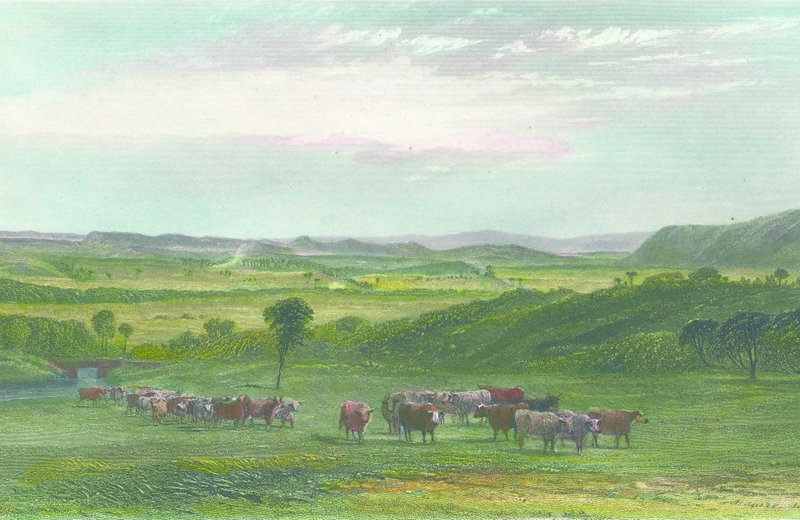
The Cowpastures and its wild cattle
The history of the Cowpastures is significant for several reasons. First, it provides the local context to John Macarthur's land grants and purchases, including the political constraints on settlement imposed by the colonial and British governments in their desire to protect the wild cattle. Second, the descriptions of the countryside made by those who ventured into the Cowpastures between 1795 and 1805 to see the wild cattle provide a lens through which to view the local landscape at the very outset of European impact on the local environment. Finally, the origins, breed, conformation and description of the wild cattle of the Cowpastures are of special interest to agricultural historians.
Summary timeline
1788 two bulls and five cows brought out on the First Fleet wandered off from Sydney Cove and were lost.
1795 the wild cattle were found thriving, south of the Nepean River. The area became known as the Cowpastures.
1801 the wild cattle numbered between 500 and 600 head.
1803 a hut was built at the Cowpastures, some bulls were shot and the beef salted.
1803 to protect the wild cattle, Government permission was required to enter the Cowpastures, and the cattle became Government property.
1804 there were between 3,000 and 5,000 wild cattle at the Cowpastures.
1805 John Macarthur was granted 5,000 acres of land at the Cowpastures to develop the merino wool industry. He named his grant 'Camden'.
1810 Governor Macquarie visited the Cowpastures and estimated the wild cattle to number between four and five thousand head.
1815 Gov. Macquarie began to build stockyards at the Cowpastures to tame or slaughter the wild cattle. Over the next few years he established stock centres at Cawdor, Stone Quarry (Picton) and Brownlow Hill.
1816 Local settlers and their workers were illegally catching or shooting the wild cattle.
1821 Nearly 900 wild cattle were tamed over the previous two years and incorporated into the Government's domestic herds. Many wild bulls were shot, their meat salted and hides tanned at Cawdor.
1824 The Government cattle at the Cowpastures were removed so that John Macarthur could take possession of 10,400 acres of land at Cawdor that he had acquired by grant and purchase.
1826 The Government tannery at Cawdor was closed.
1837 The Macarthurs' Camden Estate reached its maximum size of 27,698 acres at the Cowpastures.
1930s Probable descendants of the wild cattle were found in remote, rugged country near Mount Guouogang in the Kanangra-Boyd National Park which is part of the Blue Mountains, west of Camden.


